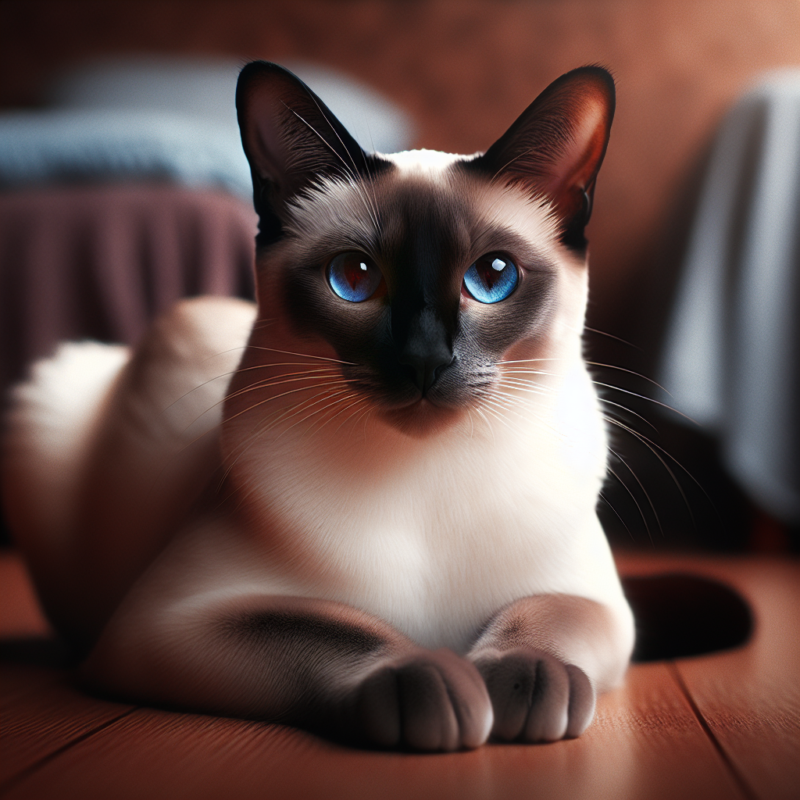About Siamese kittens
siamese cat colors
siamese cat colors
The Different Coat Colors of Siamese Cats: A Guide for Cat Lovers
Siamese cats are known for their striking appearance and unique personalities. One of the most distinctive features of these felines is their coat color. While many people may associate Siamese cats with their signature seal point color, there are actually several different coat colors that these cats can come in. In this article, we will explore the various coat colors of Siamese cats and what makes each one special.
The most well-known and traditional coat color of Siamese cats is the seal point. This color is characterized by a dark brown or black body with a lighter brown or cream color on the face, ears, paws, and tail. This color is often compared to the color of a seal, hence the name. Seal point Siamese cats are the most common and popular among cat lovers, and they are often the first image that comes to mind when thinking of this breed.
Another popular coat color for Siamese cats is the blue point. This color is similar to the seal point, but with a bluish-gray body and a lighter gray or white face, ears, paws, and tail. Blue point Siamese cats have a more subtle and elegant appearance compared to the boldness of the seal point. They are also known for their striking blue eyes, which add to their overall charm.
For those looking for a more unique and rare coat color, the chocolate point Siamese cat may be the perfect choice. This color is characterized by a light brown body and a darker brown face, ears, paws, and tail. Chocolate point Siamese cats are often mistaken for seal points at first glance, but upon closer inspection, their rich chocolate color is revealed. These cats are highly sought after by cat enthusiasts due to their rarity and stunning appearance.
How many colors do Siamese kittens have?
In addition to these three main coat colors, there are also two other variations that are less commonly seen. The first is the lilac point, which is a lighter version of the blue point with a pinkish-gray body and a lighter gray or white face, ears, paws, and tail. Lilac point Siamese cats have a delicate and ethereal appearance, making them a favorite among those who prefer a more subtle look.
The second rare coat color is the flame point, also known as the red point. This color is a combination of the seal point and the orange gene, resulting in a cream-colored body with red or orange points on the face, ears, paws, and tail. Flame point Siamese cats are often described as having a fiery and playful personality to match their vibrant coat color.
It is important to note that Siamese cats can also have a mix of these colors, known as a lynx point or tabby point. This occurs when the cat inherits the tabby gene, resulting in stripes or spots on their points. Lynx point Siamese cats can come in any of the traditional colors, but with the added pattern on their points, making them even more unique and eye-catching.
Exploring the Genetics Behind Siamese Cat Colors: From Seal Point to Blue Point

Siamese cats are known for their striking appearance and unique color patterns. These elegant felines have been a popular breed for centuries, and their distinct coloring has always been a topic of fascination for cat lovers. From the deep brown hues of the seal point to the icy blue shades of the blue point, the genetics behind Siamese cat colors are complex and intriguing.
The Siamese cat breed originated in Thailand, formerly known as Siam, and was first introduced to the Western world in the late 1800s. These cats were highly valued and were even considered sacred by the Thai people. It wasn’t until the 20th century that Siamese cats became popular in Europe and the United States, and their unique coloring was one of the main reasons for their popularity.
Blue point Siamese kittens
The most common and well-known Siamese cat color is the seal point. This color is characterized by a creamy white body with dark brown points on the face, ears, paws, and tail. The seal point is the result of a genetic mutation that causes the production of melanin, a pigment responsible for the dark coloration, to be restricted to the cooler parts of the cat’s body. This is why the points on a seal point Siamese are darker than the rest of their body.
Another popular Siamese cat color is the blue point. This color is often mistaken for gray, but it is actually a pale blue-gray shade. The blue point is the result of a dilution gene that affects the production of melanin, causing the points to be a lighter shade. This gene is also responsible for the blue eyes that are characteristic of Siamese cats.
In addition to the seal and blue points, there are two other recognized Siamese cat colors: chocolate point and lilac point. The chocolate point is similar to the seal point, but with a lighter, milk chocolate color instead of dark brown. The lilac point, on the other hand, is a pale, silvery gray color. These two colors are also the result of the dilution gene, but with different levels of expression.
What gene is responsible for a cats color?
The genetics behind Siamese cat colors are complex and involve multiple genes. The gene responsible for the pointed pattern is called the “C” gene, and there are three known variations of this gene: C, cs, and cb. The C gene is responsible for the seal point color, while the cs gene produces the chocolate point and the cb gene produces the lilac point. The dilution gene, known as the “D” gene, is responsible for the blue point color.
The inheritance of these genes follows a specific pattern. A Siamese cat must inherit two copies of the C gene to have a pointed pattern, and they must also inherit at least one copy of the D gene to have a dilute color. This means that a Siamese cat with two copies of the C gene and two copies of the D gene will have a seal point color, while a cat with one copy of the C gene and two copies of the D gene will have a blue point color.
It is also possible for Siamese cats to have a mix of colors, known as “lynx” or “tabby” points. This occurs when the cat inherits a tabby gene, which causes stripes or spots on the points. These patterns can be seen in all four Siamese cat colors and add an extra layer of complexity to the genetics behind their coloring.
The Unique Beauty of Siamese Cat Colors: A Look at the History and Variations
Siamese cats are known for their striking appearance and unique personalities. One of the most distinctive features of these felines is their coat color. Siamese cat colors have a long and fascinating history, with variations that have evolved over time. In this article, we will take a closer look at the different colors and patterns of Siamese cats, and how they have become a defining characteristic of this beloved breed.
The origins of Siamese cat colors can be traced back to ancient Siam, now known as Thailand. These cats were highly revered and were often kept as royal pets. It is believed that the first Siamese cats were seal point, with a dark brown body and darker points on their face, ears, paws, and tail. This coloration was a result of a genetic mutation that caused a temperature-sensitive enzyme to produce pigment only in cooler areas of the body, such as the extremities.
As Siamese cats became more popular in the Western world, breeders began to experiment with different colors and patterns. In the late 1800s, blue point Siamese cats were introduced, with a pale bluish-grey body and darker points. This was followed by chocolate point Siamese cats, with a lighter brown body and darker points. These variations were achieved through selective breeding and were officially recognized by cat associations in the early 1900s.
Lilac Point Siamese kittens
In the 1950s, a new color variation emerged – the lilac point Siamese. These cats have a pale, silvery-grey body and pinkish-grey points. This color is the result of a dilution gene that affects the production of pigment, resulting in a lighter shade. Lilac point Siamese cats were initially met with skepticism, but they have since gained popularity and are now recognized by most cat associations.
Aside from the traditional point colors, Siamese cats can also have tabby patterns. These cats have stripes or swirls on their body, with darker points. The most common tabby pattern in Siamese cats is the lynx point, where the stripes are more prominent on the face, giving the cat a wild and exotic look. Other tabby patterns include mackerel, classic, and ticked.
In addition to the point colors and tabby patterns, Siamese cats can also have white markings. These can range from a small spot on the chest to a large blaze on the face. White markings are not considered a fault in Siamese cats and can add to their unique appearance.
Why does my kitten’s color changing (Siamese)?
One of the most interesting aspects of Siamese cat colors is that they continue to change throughout their lives. When born, Siamese kittens are all white, with no visible points. As they grow and their body temperature regulates, the points gradually darken. This process can take up to two years, and the final color of the points may vary depending on the cat’s environment and genetics.
In recent years, new color variations have emerged in Siamese cats, such as the flame point, red point, and tortie point. These colors are the result of crossbreeding with other breeds, such as the red tabby and the tortoiseshell. While these variations are not officially recognized by all cat associations, they have gained a following among Siamese cat enthusiasts.
In conclusion, Siamese cat colors have a rich history and continue to evolve with each generation. From the traditional seal, blue, chocolate, and lilac points to the more recent flame, red, and tortie points, these cats never fail to captivate us with their unique beauty. Whether you prefer the classic look of a seal point or the exotic appearance of a lynx point, one thing is for sure – Siamese cats are truly a work of art.

